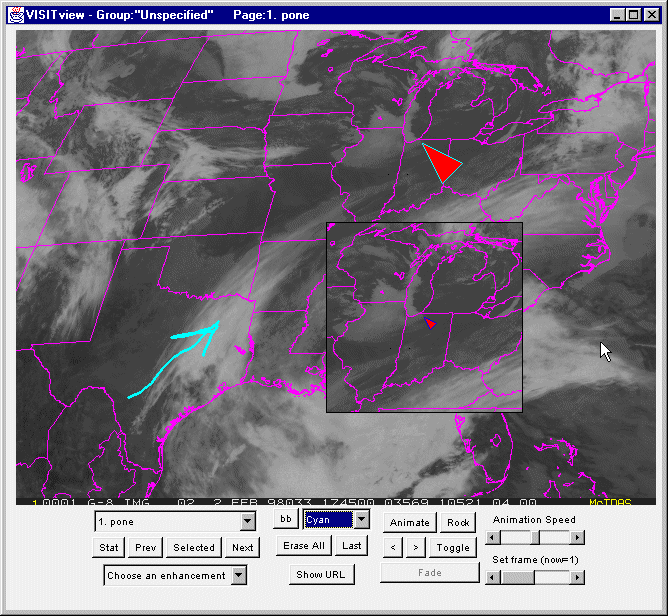VISITview Functional Overview
11/3/98
Updated: 6/11/2002
VISITView allows for the display and annotation of image loops by a
group of people using common Internet browsers. The input image files
may be either in GIF or JPEG formats, or a mixture of the two. VISITView
is set up so that one (or more) of those connected serve as the "master"
and have full control over what everyone is viewing. Others are configured
as "students" or "viewers". The "students" can also control most of the
aspects of everyone else's view screen (except the selection of the dataset
being viewed), while the "viewer" can only position the pointer to a new
location.
Here's a comprehensive list of functions that are controlled via buttons
and sliders:
-
Select a page (1 or more images) to be displayed on everyone's screen (Master
only). Selection may be by name, or just the "next" or "previous" from
a list.
-
Start/stop looping (Master & Student)
-
Set loop speed (Master & Student)
-
Single step through frames (Master & Student)
-
Zoom and un-zoom (Master & Student)
-
Set loop mode (normal or rocking) (Master & Student)
-
Move pointer (Everyone)
-
Draw straight line, rectangle, circle, or free-hand (Master & Student)
-
Automatically add an arrowhead to straight or free-hand lines.
-
Put text on image -- can specify font size on-the-fly (Master
& Student)
-
Select line and text color (Master & Student)
-
Erase either all graphics or last one done (Master & Student)
-
Fade between images (Master & Student)
-
Apply an enhancement (color table) to the images on a page (Master)
-
Select an overlay for the frame (Master)
-
Invoke a keyboard chat window (Master & Student)
-
Show (locally) an on-screen help window (Master & Student)
-
Open detailed status window (Master)
-
Toggle portal cursor on/off (Master)
This combination of functions was selected to allow for interactive training
and instruction. Instructors use the pointer (and drawing) to identify
features to teach about. Students use these same tools to indicate
what they're asking questions about.
To put things in perspective, here's a screen shot of the master
console:

on the student's console, the selectors and buttons on the far
left are replaced by simply the name of the page/dataset that is being
shown.
The controls are described in detail here.
VISITview in the classroom
The most obvious application for this is in a lab setting where students
sit in front of computer screens or terminals that can run a browser like
Netscape or IE. The instructor can control what is appearing on all the
screens at once, using the pointer (or the simple drawing tool) to highlight
features. A student may also point to features to ask questions,
and everyone gets to see what she is talking about. Most of the pages within
a lesson consist of a sequence of images (analyses, radar, satellite, etc.)
that must be viewed as a loop or be able to toggle back-and-forth between
two images quickly, in order to illustrate the phenomenon. Unlike other
collaborative tools, VISITView was designed to do just this. Of course,
it can also show single frames on a page, too.
Return to VISITview home page.

